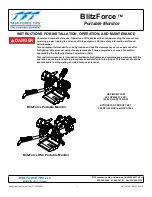
PTR306 / PTR306B Recoaters with Linear Proof Testers
Chapter 9: Troubleshooting
Rev D, October 2, 2020
Page 31
Chapter 9
Troubleshooting
9.1. Recoat Diagnostics
Problem
Possible Cause
Solution
Fiber snaps when mold top
lowered.
Fiber not loaded properly.
See Section 6.5: Loading the Fiber
Recoat mold not properly aligned
to fiber.
Refer to Section 8.3: Replace and
Align Mold Assembly for instructions
on realigning the recoat mold
assembly.
Channels of recoat mold plate are
misaligned.
Contact Thorlabs for Recoater
servicing.
Material flows excessively
outside of mold cavity or
does not flow down mold
cavity (“puddling”).
Recoat mold plates are dirty.
Dirt between quartz mold plates will
not allow them to lay flush, causing
the acrylate to flow excessively
outside the mold cavity. The recoat
mold plates should be cleaned as
described in Section 8.2.
Channels of recoat mold plate are
misaligned.
Contact Thorlabs for Recoater
servicing.
Plunger turns excessively
when injecting acrylate.
Bubbles in injector port.
Empty the recoat injector port (refer to
the Maintenance section for
instructions) and reload.
Flashing forms along the
length of the recoat.
Cure time too long.
This will increase the modulus of the
coating and make it stiffer. In the
future, decrease the cure time. This
flashing can generally be removed by
wiping the recoated section with a dry
lens tissue. Do not use a solvent! For
very tough flashing, it may be
necessary to use the gray abrasive
square (provided) to gently rub off the
flashing material.
Recoat feels tacky or can be
easily rubbed off by pulling
the fiber between fingers.
Cure time too short.
Increase the cure time.
Recoat lamp(s) burned out or
old.
Replace the recoat bulb (refer to
Section 8.3: Replace Tungsten
Halogen Lamps).
Fiber sticks to recoat mold
consistently.
Recoat mold plates are dirty.
Clean the recoat mold plates as
described in Section 8.2.
Fiber snaps when lifting the
recoat mold top.
Failed to first release the holding
fixture tops before lifting the recoat
mold top.
If the recoat mold top is lifted with the
holding fixture tops closed, the fiber
may stick to the recoat mold top and
snap or degrade the strength of the
fiber. Always open the holding fixtures
before lifting the recoat mold top.
Summary of Contents for PTR306
Page 1: ...PTR306 PTR306B Manual Fiber Recoater with Linear Proof Tester User Guide...
Page 39: ...PTR306 PTR306B Recoaters with Linear Proof Testers Chapter 10 Appendix Page 36 TTN090913 D02...
Page 41: ...PTR306 PTR306B Recoaters with Linear Proof Testers Chapter 10 Appendix Page 38 TTN090913 D02...
Page 43: ...PTR306 PTR306B Recoaters with Linear Proof Testers Chapter 10 Appendix Page 40 TTN090913 D02...
Page 48: ...www thorlabs com...















































